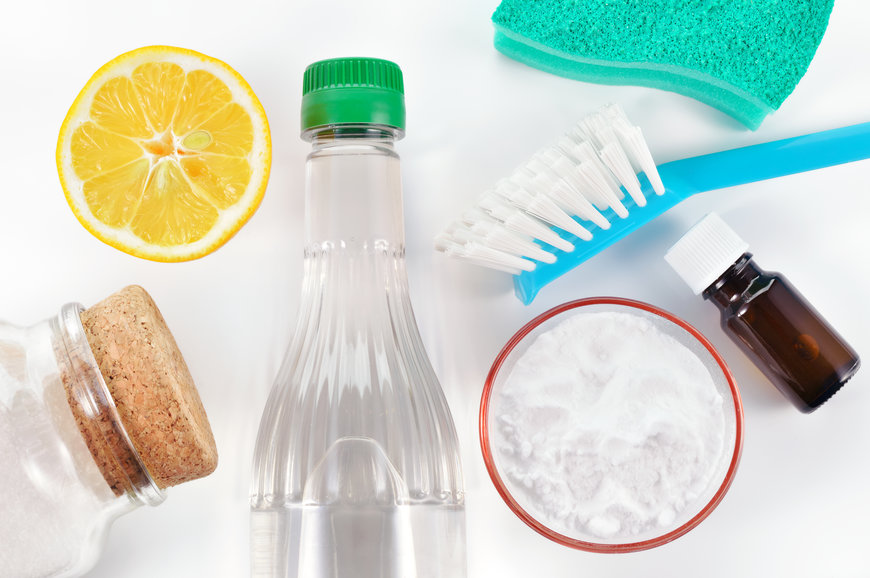Did you know the use of vinegar dates back as far as 5000 BC? It was originally used by Sumerians to preserve and pickle food. In Ancient times it was also used as a medicine, drunk as a beverage, and even used by military commander Hannibal to break apart huge boulders to allow his army to pass through the Alps! Fast forwarding to our modern era, vinegar was used by WWI medics to treat wounds. You may have memories of your grandmothers cleaning with vinegar—that distinctive smell really sticks with you! After 7000+ years, in 2013, a new type of vinegar was introduced with a higher acidity specially formulated for cleaning. This environmentally-friendly method of cleaning is not only versatile and safe, but it’s very inexpensive. It’s a win-win-win!
Now let’s dive into some of the best uses for vinegar!
Vinegar for Cleaning:
- Streak-free window and mirror cleaning: All you’ll need is a spray bottle, vinegar, water, and paper towels or a squeegee. Just mix equal parts vinegar and water, spray on the mirror or window, then wipe or squeegee!
- Cleaning automatic coffee makers: An often-overlooked item you should be cleaning regularly (but probably aren’t) is your coffee maker. The minerals in water mixed with oils from the coffee beans can lead to buildup in your reservoir, not to mention the mold, yeast, and bacteria that thrive in warm, moist environments (such as coffee makers). To clean your coffee maker with vinegar, simply fill the reservoir with vinegar (aren’t you glad vinegar is so cheap?) and start a brewing cycle. You’ll also want to follow up the vinegar cycle with a brewing cycle of plain water to rinse away any vinegar residue!
- Cleaning the microwave: This is another one that most people probably hate cleaning, but it’s a necessary evil. A super quick and easy way to clean you microwave is with vinegar! You’ll need a heat-safe cup or bowl, 1/4 cup of vinegar, 1 cup of plain water, and a clean rag or paper towels. Simply pour the vinegar and water into your cup and microwave for a minute or two—until you see steam form on the window of the microwave. Then open up the microwave and wipe it out, no scrubbing needed!
- Sparkling dishes: You don’t have to buy the fancy dishwasher detergent to get your dishes sparkling! When you’re ready to run a load of dishes, just pour 1 1/2 – 2 cups of vinegar in the bottom of your dishwasher and wash on a regular cycle with your regular amount of detergent.
- Wine stains on clothing: All you’ll need is a sponge and distilled white vinegar! Simply sponge the vinegar onto the stain until it disappears (note, you’ll need to treat the stain within 24 hours for effectiveness).
- Removing film from your bathtub and shower doors: You’ll need vinegar, baking soda and a sponge for this job. For bathtub film, wipe down the tub with vinegar on a sponge, then sprinkle the tub with baking soda. Let it sit for a couple minutes and rinse with clean water. For shower doors, simply wipe them down with vinegar on a sponge daily after your shower to prevent the buildup of soap scum.
- Cleaning no-wax floors: Rather than using soapy water or expensive floor cleaner, mop with a solution of 1/2 cup vinegar and a half-gallon of warm water. No need to rinse, just change out the water when it looks dirty.
Health Uses for Vinegar
Traditionally, vinegar has been used to clean and disinfect wounds as well as treat ailments such as ear infections, nail fungus, lice & warts! Additionally, vinegar is used as a food preservative as it inhibits the growth of E. coil bacteria. While these uses call for distilled white vinegar, the majority of health benefits come from using and ingesting apple cider vinegar.
For individuals living with Type 2 Diabetes, apple cider vinegar has been shown to lower blood sugar levels. Specifically, it has been shown to:
- reduce blood sugar by 34% after eating 50 grams of white bread
- reduce fasting blood sugar by 4% in the morning, after taking 2 tbsp of apple cider vinegar at bedtime
- improve insulin sensitivity and function after meals
If you’re trying to lose weight, studies have shown that vinegar can help you eat fewer calories by increasing your satiety, or feeling of fullness after eating, ultimately contributing to weight loss (as part of a healthy diet and lifestyle, of course—it can’t work miracles).
Another benefit of apple cider vinegar is related to cholesterol and heart health. Drinking apple cider vinegar can lower cholesterol and triglyceride levels, reduce blood pressure, and decrease your overall risk of heart disease.
So how do you use apple cider vinegar to get these benefits? You can cook with it, making homemade salad dressings or homemade mayonnaise; it’s also common to dilute the vinegar in water (try anywhere from 1 teaspoon to 2 tablespoons mixed in a large glass of water). For the best results, it’s recommended to use a brand that’s organic and unfiltered, like Braggs.
As you can see, vinegar in its many varieties is one of the cheapest, most versatile solutions on the market for all areas of your life! How do you like to use vinegar?

